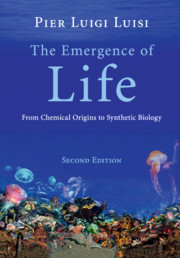Book contents
- Frontmatter
- Contents
- Acknowledgments
- Introduction
- Part I Approaches to the origin of life
- 1 Setting the stage
- 2 The hardware
- 3 Ascending the ramp of complexity
- 4 Experimental approaches to the origin of life
- 5 Origin of life from ground zero
- Part II What is life? The bio-logics of cellular life
- Part III Order and organization in biological systems
- Part IV The world of vesicles
- Part V Towards the synthetic biology of minimal cells
- As a way of conclusion
- Appendix The open questions about the origin of life
- References
- Names index
- Subject index
2 - The hardware
from Part I - Approaches to the origin of life
Published online by Cambridge University Press: 05 September 2016
- Frontmatter
- Contents
- Acknowledgments
- Introduction
- Part I Approaches to the origin of life
- 1 Setting the stage
- 2 The hardware
- 3 Ascending the ramp of complexity
- 4 Experimental approaches to the origin of life
- 5 Origin of life from ground zero
- Part II What is life? The bio-logics of cellular life
- Part III Order and organization in biological systems
- Part IV The world of vesicles
- Part V Towards the synthetic biology of minimal cells
- As a way of conclusion
- Appendix The open questions about the origin of life
- References
- Names index
- Subject index
Summary
Introduction
In the previous chapter, we have seen the richness of concepts and philosophical implications that the origin of life is bound to arise. The implementation of the origin of life is, however, a chemical process, and it is necessary then to look at the chemistry underlying such a process. In this chapter, we will take a look at the chemical compounds which were there “at disposal” of the emerging life. We will also review some basic reactions taking place among these compounds in prebiotic times. In a way, this will give us a picture of the hardware on which the Oparin's ladder argument might have been developing. Chemistry, however, has its own rules and in the following chapter, we will then see how the constraints of chemistry may influence and possibly hinder the implementation and our own understanding of the process of growth from non-life to life.
What did we have 4 billion years ago?
Before considering what may happen in a warm little pond, let us have an overview of the inventory of the chemical compounds possibly available on Earth at the onset of the chemical process of the origin of life, say 4 Gya (billion years ago). Generally, we will have to deal with endogenous material, made on Earth; and exogenous material, coming from space. In recent years, bioastronomy (some prefer the term astrobiology, others exobiology) has, in fact, played a very important role in the field of the origin of life (see Zhao and Bada, 1989; Miller and Bada, 1991; Chyba and Sagan, 1992; Oró, 2002). A very interesting and important point in this regard is the similarity of the molecules from space and the molecules of Earth, which indicates the unity of basic chemistry in the universe.
The amount of space dust falling presently on Earth amounts to c. 40 000 tons per year (much less than in the long past), which, spread over all Earth's surface, corresponds to only 8 × 10−9 g cm−2 per year (Love and Brownlee, 1993; Miller, 1998; Oró, 2002). On the other hand, accumulation over billions of years can still result in a considerable amount of matter.
Let us consider first Table 2.1, which gives a compact account of the main sources, both terrestrial and extraterrestrial, of prebiotic organic compounds in the primitive Earth.
- Type
- Chapter
- Information
- The Emergence of LifeFrom Chemical Origins to Synthetic Biology, pp. 31 - 56Publisher: Cambridge University PressPrint publication year: 2016
- 1
- Cited by



